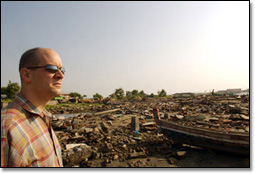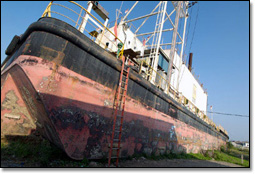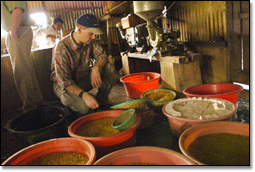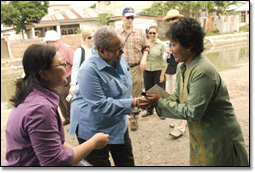Bob Seipel, a program manager for Boeing Space & Intelligence Systems Mission Systems, is reporting for Boeing News Now this week from Banda Aceh, Indonesia. He is part of a delegation led by the company's Global Corporate Citizenship function to investigate the progress of the rebuilding in Aceh province on the island of Sumatra, one of the areas hit hardest by the December 2004 Southeast Asian tsunami.
Boeing employees and retirees' donations accounted for nearly $2 million of the total Boeing contributions of $4.5 million split among three international relief agencies -- the American Red Cross, Mercy Corps and CARE, the latter two of which are sponsoring this site investigation. It is Seipel's responsibility on this trip to be the eyes and ears of Boeing employees and retirees who gave so generously to this disaster and to report back on how their dollars and those of the company are being spent in the relief efforts.
Each days events: Day 1, Day 2, Day 3, Day 4, Day 5
Day 1, JAN 29:

Boeing's Bob Seipel observes the coastline in Aceh province. Debris and rubble of all kinds still mar the shores. Abandoned and damaged boats sit on dry land, far from the water and clearly unusable. (Photo courtesy Mercy Corps)
Hope, optimism and the business of tofu making
After many months of preparation and planning -- and many days of traveling and what seemed like countless takeoffs and landings of a variety of Boeing-made aircraft -- we finally arrived at our final destination of Banda Aceh late Sunday afternoon. I have eagerly anticipated this moment from back in July 2006, when I was chosen to take part in this site investigation representing my Boeing colleagues.
As we walk across the tarmac, the weather is surprisingly mild after the heat of Jakarta, our first stop in Indonesia. The sun seems brighter here, the air less heavy. It's a good start.
Flying into the Aceh airport from the larger city of Medan about 300 miles (480 km) southeast, I was excited by what looked to be a field of green rice paddies, which indicated to me that the area was coming back, albeit slowly, from the destruction of more than two years before.
These feelings were tempered somewhat by the devastation we witnessed as we drove through the city this morning closer to the "ground zero" of the coastline. New homes and those in various stages of construction stand side by side with those hopelessly destroyed. Debris and rubble of all kinds still mar the shores. Abandoned and damaged boats sit on dry land, far from the water.

This 3,500-ton barge that housed an offshore power station was swept two miles (3.2 km) inland on a massive wave and dropped in the middle of a local neighborhood. Too large to move, it was made operational and provides electricity to the nearby area. (Photo courtesy Mercy Corps)
In fact, one of our first site visits was to a 3,500-ton barge housing an offshore power station that apparently rode the waves more than two miles (3.2 km) inland and was dropped into the middle of a small neighborhood, crushing people, buildings and cars. The unmovable barge now provides much-needed electricity to the homes in the area.
While it stands as proof of the incredible power of nature, in many ways, this "electric boat," as they call it, is a symbol of the resiliency and determination of the Aceh people -- making what is essentially a burial ground into something useful and life-giving.
That's one thing you notice here right away -- the warmth of the people, their optimism and their ready smiles. They seem truly happy to see you. Even after one of the greatest disasters of recorded history, not to mention more than 30 years of military conflict, the people here radiate hope -- the most necessary tool of survival.
After a while, we made our way to the offices of Mercy Corps, our host for the first few days of our investigation after which CARE will be our guide. There we met a group of very impressive, high-energy people, equal parts American-born and native Indonesians, some of whom have been here for nearly the whole duration since the disaster.
After an extensive presentation from the office leadership and much interesting discussion, I'm pleased to report that the people making use of our contribution to Mercy Corps are intense, resourceful and experienced individuals. Everyone shares an unswerving dedication to restoring the livelihoods of those the disaster spared, regardless of the potential dangers and their own discomfort.

Seipel reviews the various stages of tofu production in a small business the Boeing group visited on the first day of their weeklong site investigation in Banda Aceh, Indonesia. (Photo courtesy Mercy Corps)
I also was reassured to note that the more than 400 Mercy Corps staff members in Banda Aceh are good businesspeople as well. My evidence is the rigorous compliance, financial/accounting, and monitoring and evaluation systems and processes they put in place almost immediately upon their arrival on the scene. "Our intent is to innovate on, maximize and leverage what we are doing every day," Sasha Muench, deputy director of the organization's Aceh program, explained to our group -- which should sound very familiar to us Lean+ devotees at Boeing.
Later in the day, we had the opportunity to meet a few beneficiaries of Mercy Corps' Financial Access program, which guarantees loans to small-business owners to help them start or rebuild their businesses.
One such beneficiary is a woman named Ms. (or "Ibu," as they say here) Suwarsi, who started her tofu-making business in 1997, only to have it destroyed by the tsunami. She lost all of her production machinery and tools as well as her raw material. She managed to reopen her business in June 2005, but found she needed help to be successful. Later that year, a loan facilitated by Mercy Corps (of what equated to just over $2,700) enabled her to ramp up production by 50 percent and employ six other people. Now she produces about 400 kilograms (roughly 900 pounds) of tofu a day, which she distributes locally and down the coast by ferry.

Boeing Global Corporate Citizenship's Linda Martin (center) says goodbye to Ms. Suwarsi (right), the owner of a tofu-making business that benefited from a loan guaranteed by Mercy Corps. Mercy Corps representative Meynar Sihombing (left) translates. (Photo courtesy Mercy Corps)
Boeing Global Corporate Citizenship's Linda Martin (center) says goodbye to Ms. Suwarsi (right), the owner of a tofu-making business that benefited from a loan guaranteed by Mercy Corps. Mercy Corps representative Meynar Sihombing (left) translates. (Photo courtesy Mercy Corps)
A member of our group asked Suwarsi if she felt like life was finally "back to normal" for her now, expecting to hear about how she felt after going through such an ordeal. She responded that she was still not happy with her company's output. Thinking that she may have misunderstood, our group member pressed the translator to ask the question again. The answer was the same: "I would like to increase production by at least another 50 percent. I should be producing at least 800 kilograms by now." When you think about it, a true businessperson could not possibly answer anything else.
For more information about Mercy Corps' efforts in Banda Aceh and other tsunami-affected areas in the region, visit the organization's Web site.
|

